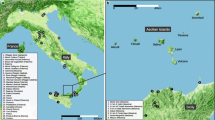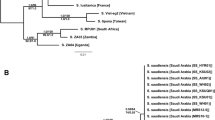Abstract
Sixty-five sequences of the mitochondrial DNA cytochrome b gene fragment (759 bp) and 23 sequences of the NADH dehydrogenase subunit 6 gene fragment (224 bp) were compared in ants of the genus Formica L. from different regions of the Palearctic and in Polyergus rufescens Latr. as outgroup. In total, 28 species of the genus Formica were examined. As a result, dated trees with a molecular clock were constructed showing the phylogenetic relationships of Formica ants. The topology of the obtained tree based on the Cyt-b sequences was found to be not consistent with the generally accepted opinion on the Formica rufa and F. rufibarbis groups. New data on the formation history of the present-day fauna of Formica ants of the Palearctic were obtained. It was demonstrated that a considerable fraction of the examined species (about a third) were formed in the Quaternary Period.
Similar content being viewed by others
References
Dlussky, G.M., Murav’i roda Formica (Ants of the Genus Formica), Moscow: Nauka, 1967.
Dlussky, G.M., Murav’i pustyn’ (Ants of Deserts), Moscow: Nauka, 1981.
An Online Catalog of the Ants of the World. http://www.antcat.org/
Zakharov, A.A. and Zakharov, R.A., The phenomenon of mixed families in red wood ants, in Murav’i i zashchita lesa (Ants and the Forest Conservation) (Proc. 13th All-Russ. Mirmecol. Symp.), Nizhny Novgorod: Nizhegorodsrii Gos. Univ., 2009, pp. 160–165.
Seifert, B. and Goropashnaya, A.V., Ideal phenotypes and mismatching haplotypes—errors of mtDNA treeing in ants (Hymenoptera: Formicidae) detected by standardized morphometry, Org. Diversity Evol., 2004, vol. 4, pp. 295–305. doi 10.1016/jode.2004.04.005
Moreau, C.S., Inferring ant evolution in the age of molecular data (Hymenoptera: Formicidae), Myrmecol. News, 2009, vol. 12, pp. 201–210.
Moreau, C.S. and Bell, C.D., Fossil cross-validation of the dated ant phylogeny (Hymenoptera: Formicidae), Entomol. Am., 2011, vol. 117, pp. 22–27. doi 10.1664/10-RA-012.1
Goropashnaya, A.V., Fedorov, V.B., Seifert, B., et al., Limited phylogeographical structure across Eurasia in two red wood ant species Formica pratensis and F. lugubris (Hymenoptera, Formicidae), Mol. Ecol., 2004, vol. 13, no. 7, pp. 1849–1858. doi 10.1111/j.1365- 294X.2004.02189x
Goropashnaya, A.V., Fedorov, V.B., and Pamilo, P., Recent speciation in the Formica rufa group ants (Hymenoptera, Formicidae): inference from mitochondrial DNA phylogeny, Mol. Phylogenet. Evol., 2004, vol. 32, no. 1, pp. 198–206. doi 10.1016/jympev. 2003.11.016
Goropashnaya, A.V., Fedorov, V.B., Seifert, B., et al., Phylogeography and population structure in the ant Formica exsecta (Hymenoptera, Formicidae) across Eurasia reflected by mitochondrial DNA variation and microsatellites, Ann. Zool. Fennici, 2007, vol. 44, no. 6, pp. 462–474.
Goropashnaya, A.V., Fedorov, V.B., Seifert, B., et al., Phylogenetic relationships of Palearctic Formica species (Hymenoptera, Formicidae) based on mitochondrial cytochrome B sequences, PLoS One, 2012, vol. 7, no. 7, E41697. doi 10.1371/journalpone.0041697
Gyllenstrand, N. and Seppa, P., Conservation genetics of the wood ant, Formica lugubris, in a fragmented landscape, Mol. Ecol., 2003, vol. 12, no. 11, pp. 2931–2940. doi 10.1046/j.1365-294X.2003.01975x
Gyllenstrand, N., Seppa, P., and Pamilo, P., Restricted gene flow between two social forms in the ant Formica truncorum, J. Evol. Biol., 2005, vol. 18, no. 4, pp. 978–984. doi 10.1111/j.1420-9101.2005.00908x
Holzer, B., Keller, L., and Chapuisat, M., Genetic clusters and sex-biased gene flow in a unicolonial Formica ant, BMC Evol. Biol., 2009, vol. 9, no. 1, p. 69. doi 10.1186/1471-2148-9-69
Jansen, G., Savolainen, R., and Vepsalainen, K., Phylogeny, divergence—time estimation, biogeography and social parasite-host relationships of the Holarctic ant genus Myrmica (Hymenoptera: Formicidae), Mol. Phylogenet. Evol., 2010, vol. 56, no. 1, pp. 294–304. doi 10.1016/jympev.2010.01.029
Johnson, R.N., Agapow, P.M., and Crozier, R.H., A tree island approach to inferring phylogeny in the ant subfamily Formicinae, with especial reference to the evolution of weaving, Mol. Phylogenet. Evol., 2003, vol. 29, no. 2, pp. 317–330. doi 10.1016/S1055-7903(803)00114-3
Maki-Petays, H. and Breen, J., Genetic vulnerability of a remnant ant population, Conserv. Genet., 2007, vol. 8, no. 2, pp. 427–435. doi 10.1007/s10592-006-9182-1
Lukashov, V.V., Molekulyarnaya evolyutsiya i filogeneticheskii analiz (Molecular Evolution and Phylogenetic Analysis), Moscow: BINOM, Laboratoriya znanii, 2009.
Goropashnaya, A.V., Phylogeographic Structure and Genetic Variation in Formica Ants, PhD Thesis, Uppsala: Uppsala Univ., 2003.
GenBank, NCBI. http://www.ncbi.nlm.nih.gov/
Hall, T.A., BioEdit: a user-friendly biological sequence alignment editor and analysis program for Windows 95/98/NT, Nucleic Acids Symp. Ser., 1999, vol. 41, pp. 95–98.
Goujon, M., McWilliam, H., Li, W., et al., A new bioinformatics analysis tools framework at EMBL-EBI, Nucleic Acids Res., 2010, vol. 38, no. 2, pp. W695–W699. doi 10.1093/nar/gkq313
FaBox. http://users-birc.au.dk/biopv/php/fabox/
Tajima, F., Simple methods for testing molecular clock hypothesis, Genetics, 1993, vol. 135, no. 2, pp. 599–607.
Paradis, E., Claude, J., and Strimmer, K., APE: analyses of phylogenetics and evolution in R language, Bioinformatics, 2004, vol. 20, no. 2, pp. 289–290. doi 10.1093/bioinformatics/btg412
Paradis, E., Pegas: an R package for population genetics with an integrated–modular approach, Bioinformatics, 2010, vol. 26, no. 3, pp. 419–420. doi 10.1093/bioinformatics/btp696
Kabacoff, R.I., R in Action: Data Analysis and Graphics with R, New York: Manning, 2011.
Darriba, D., Taboada, G.L., Doallo, R., et al., ModelTest 2: more models, new heuristics and parallel computing, Nat. Methods, 2012, vol. 9, no. 8, p. 772. doi 10.1038/nmeth.2109
Ronquist, F., Teslenko, M., van der Mark, P., et al., MrBayes 3.2: efficient Bayesian phylogenetic inference and model choice across a large model space, Syst. Biol., 2012, vol. 61, no. 3, pp. 539–542. doi 10.1093/sysbio/sys029
Dlussky, G.M., Ants of the tribe Formicini (Hymenoptera, Formicidae) from Late Eocene amber of Europe, Paleontol. J., 2008, vol. 42, no. 5, pp. 500–513.
PHYLOCH. http://www.christophheibl.de/Rpackages.html/
BOOT. http://cran.r-project.org/web/packages/simpleboot/index.html/
Waddell, P.J. and Steel, M.A., General time-reversible distances with unequal rates across sites: mixing gamma and inverse Gaussian distributions with invariant sites, Mol. Phylogenet. Evol., 1997, vol. 8, no. 3, pp. 398–414. doi 10.1006/mpev.1997.0452
Kimura, M., A simple method for estimating evolutionary rates of base substitutions through comparative studies of nucleotide sequences, J. Mol. Evol., 1980, vol. 16, no. 2, pp. 111–120.
Farias, I.P., Ortí, G., Sampaio, I., et al., The cytochrome b gene as a phylogenetic marker: the limits of resolution for analyzing relationships among cichlid fishes, J. Mol. Evol., 2001, vol. 53, no. 2, pp. 89–103. doi 10.1007/s002390010197
Minchenko, A.T. and Dudareva, N.A., Mitochondrial Genom, Novosibirsk: Nauka, 1990.
Yang, S., Li, X., Cai, L.G., and Qian, Z.Q., Characterization of the complete mitochondrial genome of Formica selysi (Insecta: Hymenoptera: Formicidae: Formicinae), Mitochondrial DNA, 2015, vol. 26, pp. 1–3. doi 10.3109/19401736.2015.1018229
Papadopoulou, A., Anastasiou, I., and Vogler, A.P., Revisiting the insect mitochondrial molecular clock: the mid-Aegean trench calibration, Mol. Biol. Evol., 2010, vol. 27, no. 7, pp. 1659–1672. doi 10.1093/molbev/msq051
Mayr, E., Linsley, E., and Usinger, R., Methods and Principles of Systematic Zoology, New York: McGraw-Hill, 1953.
Seifert, B. and Schultz, R.B., A taxonomic revision of the Formica rufibarbis Fabricius, 1793 group (Hymenoptera: Formicidae), Myrmecol. News, 2009, vol. 12, pp. 255–272.
Sinitsyn, V.M., Vvedenie v paleoklimatologiyu (Introduction to Paleoclimatology), Leningrad: Nedra, 1980.
Dlusskii, G.M. and Rasnitsyn, A.P., Paleontological record and stages of ant evolution, Usp. Sovrem. Biol., 2007, vol. 127, no. 2, pp. 118–134.
Zhamoida, A.I., Obshchaya stratigraficheskaya shkala, prinyataya v SSSR—Rossii: ee znachenie, naznachenie i sovershenstvovanie (General Stratigraphic Scale Adopted in the Soviet Union—Russia: Its Value, Purpose and Improvement), St. Petersburg: Vseross. Nauchno-Issled. Geol. Inst., 2013.
Wu, J., Taxonomic studies on the genus Formica L. of China (Hymenoptera: Formicidae), For. Res., 1990, vol. 3, pp. 1–8.
Seifert, B., A taxonomic revision of the Formica cinerea group (Hymenoptera: Formicidae), Abh. Ber. Naturkd. Mus. Görlitz, 2002, vol. 74, no. 2, pp. 245–272.
Seifert, B., A taxonomic revision of the ant subgenus Coptoformica Mueller, 1923 (Hymenoptera, Formicidae), Zoosystema, 2000, vol. 22, no. 3, pp. 517–568.
Seifert, B., The “Black Bog Ant” Formica picea Nylander, 1846—a species different from Formica candida Smith, 1878 (Hymenoptera: Formicidae), Myrmecol. Nachr., 2004, vol. 6, pp. 29–38.
Zakharov, A.A., Dlusskii, G.M., Goryunov, D.N., et al., Monitoring murav’ev Formica (Monitoring of Formica Ants), Moscow: KMK, 2013.
Seifert, B., Formica paralugubris nov. spec.—a sympatric sibling species of Formica lugubris from the western Alps (Insecta: Hymenoptera: Formicoidea: Formicidae), Reichenbachia, 1996, vol. 31, no. 35, pp. 193–201.
Author information
Authors and Affiliations
Corresponding author
Additional information
Original Russian Text © I.A. Antonov, Yu.S. Bukin, 2016, published in Genetika, 2016, Vol. 52, No. 8, pp. 919–930.
Rights and permissions
About this article
Cite this article
Antonov, I.A., Bukin, Y.S. Molecular phylogenetic analysis of the ant genus Formica L. (Hymenoptera: Formicidae) from Palearctic region. Russ J Genet 52, 810–820 (2016). https://doi.org/10.1134/S1022795416080020
Received:
Accepted:
Published:
Issue Date:
DOI: https://doi.org/10.1134/S1022795416080020




